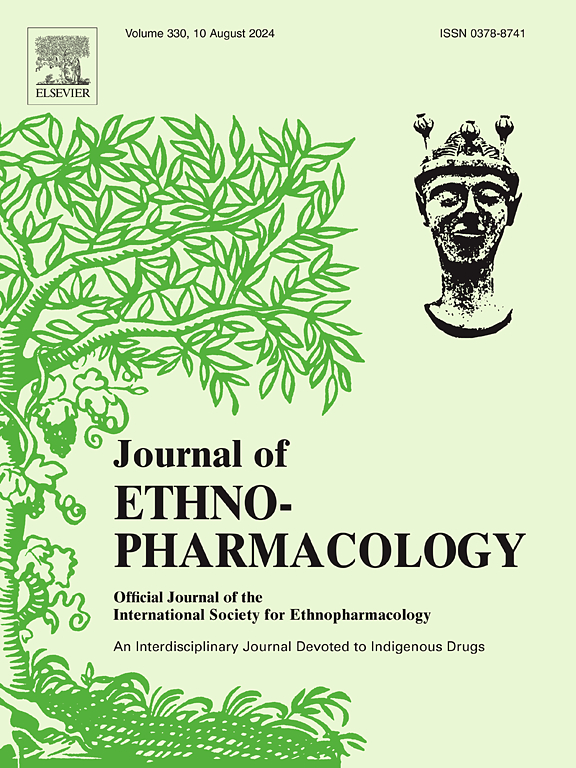Study on the modulation of kidney and liver function of rats with diabetic nephropathy by Huidouba through metabolomics
IF 5.4
2区 医学
Q1 CHEMISTRY, MEDICINAL
引用次数: 0
Abstract
Ethnopharmacological relevance
Huidouba (HDB), a traditional Tibetan medicine, has been used for centuries in the Emei Mountain region of Sichuan, China, to treat diabetes and its complications. Known for its efficacy in nourishing kidney-Yin (kidney water) and regulating glucose and lipid metabolism, it is considered a“wonder drug”of Mount Emei.The study of Huidouba holds great significance for elucidating the mechanisms of action by which traditional Chinese and ethnic medicines treat diseases.
Aim of the study
To investigate the therapeutic effects and underlying mechanisms of Huidouba on diabetic nephropathy (DN) using metabolomic and molecular approaches.
Materials and methods
DN rat model was established using high fat diet and streptozotocin (STZ 30 mg/kg) injection. The 65 rats included in the study were divided into normal group, metformin positive control model group, HDB high dose group and HDB low dose group with 13 rats in each group by using random number table method.The rats in HDB treatment group were given a high dose (7.2 g/kg) and a low dose (3.6 g/kg) respectively for 8 weeks. Serum biochemical indices of rats were detected and histopathological analyses of liver, kidney and pancreas were performed. Metabolomics analysis of plasma was performed using UPLC-MS/MS technique. Western blot was used to analyse the expression of key proteins in the bile acid metabolic pathway.
Results
HDB administration modulated aberrant metabolic pathways in DN rats, leading to ameliorated hepato-renal functions. Notably, renal dysfunction markers were markedly attenuated: blood urea nitrogen (BUN) declined from 16.27 ± 3.32 mmol/L to 8.95 ± 1.24 mmol/L (HDBL) and 11.80 ± 1.52 mmol/L (HDBH), while serum creatinine (SCr) reduced from 56.00 ± 15.96 μmol/L to 28.75 ± 2.33 μmol/L (HDBL) and 28.01 ± 2.93 μmol/L (HDBH). Albumin-to-creatinine ratio (ACR-8) dropped from 7.68 ± 2.44 mg/g (Model) to 4.39 ± 0.92 mg/g (HDBL) and 5.20 ± 1.80 mg/g (HDBH), indicating preserved glomerular filtration.Hepatoprotective effects were evident, with alanine aminotransferase (ALT) levels decreasing from 148.6 ± 63.73 μmol/L (Model) to 90.45 ± 20.35 μmol/L (HDBL) and 82.67 ± 19.55 μmol/L (HDBH). Aspartate aminotransferase (AST) levels also trended downward (Model: 253.6 ± 225.9 μmol/L vs. HDBH: 147.5 ± 42.18 μmol/L). Histologically, HDB treatment reduced inflammatory infiltration in the liver, kidney, and pancreatic islets, alongside ameliorated tissue degeneration, including a significant reduction in renal fibrosis (renal fibrotic area percentage in the Model group was approx. 13.32 %, which decreased to approx. 7.31 % and 8.68 % in the HDB low and high dose groups, respectively). Untargeted metabolomics revealed upregulated bile acid metabolism pathways (Cholesterol 7alpha-hydroxylase (CYP7A1) and Farnesoid X receptor (FXR/NR1H4)), correlating with improved glucose-lipid homeostasis and attenuated oxidative stress.
Conclusions
The results of the study showed that both high- and low-dose HDB treatments effectively influenced key parameters in DN rats. High-dose HDB demonstrated superior efficacy in reducing total cholesterol (TC), low-density lipoprotein-cholesterol (LDL-C), and ALT levels, while significantly elevating high-density lipoprotein-cholesterol (HDL-C) and insulin (INS) levels compared to the low-dose group. In contrast, low-dose HDB showed a more pronounced reduction in BUN. These findings indicate complex dose-related protective effects. While low-dose HDB showed a more pronounced reduction in BUN and renal fibrosis, high-dose HDB exhibited stronger regulation of glucose-lipid metabolism and insulin secretion. This latter effect involving glucose-lipid homeostasis is likely mediated through its more pronounced modulation of bile acid pathways (e.g., CYP7A1 and NR1H4 upregulation by high-dose HDB). Both doses alleviated liver damage by reducing ALT and AST levels, though high-dose HDB achieved a more significant reduction in hepatic steatosis and inflammatory infiltration. HDB not only improved renal function in DN rats (e.g., BUN decreased from 16.27 mmol/L in the Model group to 8.95 mmol/L in the HDBL group and 11.80 mmol/L in the HDBH group), but also significantly improved renal tissue structure, with quantitative Masson staining analysis showing a reduction in renal fibrotic area from 13.32 % in the Model group to approximately 7.31 % in the HDBL group and 8.68 % in the HDBH group, respectively. HDB demonstrated potential in regulating glucolipid metabolism and protecting the liver. The dose-dependent efficacy observed, particularly concerning these aspects of glucolipid metabolism and certain liver parameters where the high dose showed greater improvements, appears consistent with the trend for high-dose HDB to more strongly modulate bile acid signaling markers (such as CYP7A1 and NR1H4), a key pathway in metabolic regulation, suggesting a potential association.Furthermore, HDB modulates altered metabolic states by modulating the abnormal bile acid metabolism pathway associated with Type 2 Diabetes Mellitus (T2DM). Therefore, we believe that HDB is a promising ethnopharmaceutical for the amelioration of T2DM.

通过代谢组学研究回豆坝对糖尿病肾病大鼠肾、肝功能的调节作用。
民族药物学意义:回斗巴是一种传统藏药,在中国四川峨眉山地区用于治疗糖尿病及其并发症已有几个世纪的历史。它以滋补肾阴(肾水)和调节糖脂代谢的功效而闻名,被认为是峨眉山的“灵丹妙药”。回斗坝的研究对阐明中药和民族药治疗疾病的作用机制具有重要意义。目的:应用代谢组学和分子生物学方法研究回豆巴对糖尿病肾病(DN)的治疗作用及其机制。材料与方法:采用高脂饲料和stz30 mg/kg注射链脲佐菌素建立DN大鼠模型。采用随机数字表法将65只大鼠分为正常组、二甲双胍阳性对照模型组、HDB高剂量组和HDB低剂量组,每组13只。HDB治疗组大鼠分别给予高剂量(7.2 g/kg)和低剂量(3.6 g/kg),连续8周。检测大鼠血清生化指标,并对肝、肾、胰腺进行组织病理学分析。血浆代谢组学分析采用UPLC-MS/MS技术。Western blot分析胆汁酸代谢途径关键蛋白的表达。结果:HDB可调节DN大鼠异常代谢途径,改善肝肾功能。血清肌酐(SCr)由56.00±15.96 μmol/L降至28.75±2.33 μmol/L (HDBL)和28.01±2.93 μmol/L (HDBH),血尿素氮(BUN)由16.27±3.32 mmol/L降至8.95±1.24 mmol/L (HDBL)和11.80±1.52 mmol/L (HDBH)。白蛋白/肌酐比值(ACR-8)由模型(7.68±2.44 mg/g)降至4.39±0.92 mg/g (HDBL)和5.20±1.80 mg/g (HDBH),提示肾小球滤过保留。肝保护作用明显,谷丙转氨酶(ALT)水平从148.6±63.73 μmol/L(模型)降至90.45±20.35 μmol/L (HDBL)和82.67±19.55 μmol/L (HDBH)。谷草转氨酶(AST)水平也呈下降趋势(模型:253.6±225.9 μmol/L vs. HDBH: 147.5±42.18 μmol/L)。组织学上,HDB治疗减少了肝脏、肾脏和胰岛的炎症浸润,同时改善了组织变性,包括肾纤维化的显著减少(模型组肾纤维化面积百分比约为)。13.32%,下降到约。HDB低、高剂量组分别为7.31%、8.68%)。非靶向代谢组学显示胆酸代谢途径(胆固醇7 α -羟化酶(CYP7A1)和法尼脂X受体(FXR/NR1H4))上调,与改善糖脂稳态和减轻氧化应激相关。结论:本研究结果表明,高、低剂量HDB治疗均能有效影响DN大鼠的关键参数。与低剂量组相比,高剂量组在降低总胆固醇(TC)、低密度脂蛋白-胆固醇(LDL-C)和ALT水平方面表现出优越的疗效,同时显著提高高密度脂蛋白-胆固醇(HDL-C)和胰岛素(INS)水平。相比之下,低剂量的组屋组屋显示出更明显的BUN减少。这些发现表明了与剂量相关的复杂保护作用。低剂量HDB对BUN和肾纤维化的减少更为明显,而高剂量HDB对糖脂代谢和胰岛素分泌的调节更强。后一种作用涉及糖脂稳态,可能是通过其更明显的胆酸通路调节介导的(例如,高剂量HDB上调CYP7A1和NR1H4)。两种剂量均通过降低ALT和AST水平减轻肝损伤,尽管高剂量HDB对肝脂肪变性和炎症浸润的减少更为显著。HDB不仅改善了DN大鼠的肾功能(如BUN从模型组的16.27 mmol/L降至HDBL组的8.95 mmol/L, HDBH组的11.80 mmol/L),而且显著改善了肾组织结构,定量Masson染色分析显示肾纤维化面积分别从模型组的13.32%减少到HDBL组的约7.31%和HDBH组的8.68%。HDB显示出调节糖脂代谢和保护肝脏的潜力。观察到的剂量依赖性疗效,特别是在糖脂代谢和某些肝脏参数方面,高剂量表现出更大的改善,似乎与高剂量HDB更强地调节胆酸信号标记(如CYP7A1和NR1H4)的趋势一致,这是代谢调节的关键途径,表明可能存在关联。 此外,HDB通过调节与2型糖尿病(T2DM)相关的异常胆汁酸代谢途径来调节代谢状态的改变。因此,我们认为HDB是一种很有前途的改善2型糖尿病的民族药。
本文章由计算机程序翻译,如有差异,请以英文原文为准。
求助全文
约1分钟内获得全文
求助全文
来源期刊

Journal of ethnopharmacology
医学-全科医学与补充医学
CiteScore
10.30
自引率
5.60%
发文量
967
审稿时长
77 days
期刊介绍:
The Journal of Ethnopharmacology is dedicated to the exchange of information and understandings about people''s use of plants, fungi, animals, microorganisms and minerals and their biological and pharmacological effects based on the principles established through international conventions. Early people confronted with illness and disease, discovered a wealth of useful therapeutic agents in the plant and animal kingdoms. The empirical knowledge of these medicinal substances and their toxic potential was passed on by oral tradition and sometimes recorded in herbals and other texts on materia medica. Many valuable drugs of today (e.g., atropine, ephedrine, tubocurarine, digoxin, reserpine) came into use through the study of indigenous remedies. Chemists continue to use plant-derived drugs (e.g., morphine, taxol, physostigmine, quinidine, emetine) as prototypes in their attempts to develop more effective and less toxic medicinals.
 求助内容:
求助内容: 应助结果提醒方式:
应助结果提醒方式:


